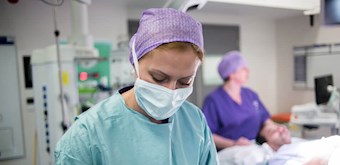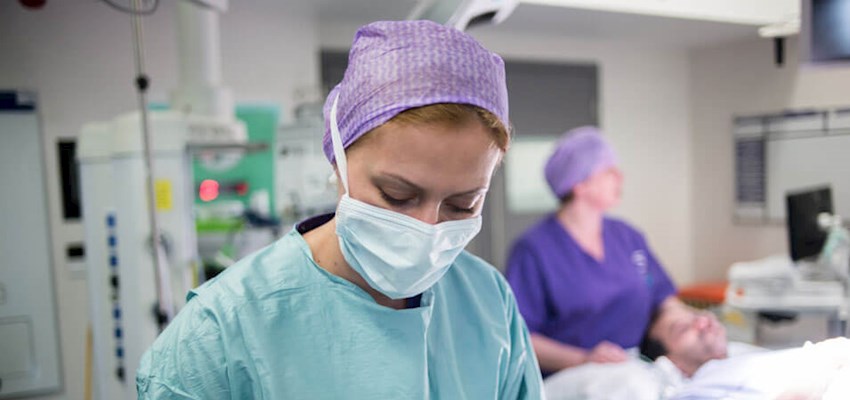Private knee arthroscopy surgery
A minimally invasive procedure for knee problems
Arthroscopy is a keyhole procedure used to evaluate and diagnose conditions like cartilage damage and arthritis
What is a knee arthroscopy?
If you’re experiencing ongoing pain in your knee, arthroscopy is a simple, straightforward procedure that allows your consultant to see inside your knee joint using a small surgical camera (arthroscope) that transmits images to a high-definition monitor. It’s used to diagnose a range of joint problems and conditions, including arthritis.
As well as diagnosis, arthroscopy is also used to treat a range of common knee problems without the need for open surgery – for example, repairing damaged cartilage or removing a Baker's cyst.
Why do I need a knee arthroscopy?
Knee arthroscopy tends to be more common among older age groups. That’s because, the older you get, the more wear and tear your knees have been exposed to, leading to an increased likelihood of painful conditions.
However, younger people who exercise a lot can also develop knee pain. Overuse and injury can lead to knee problems that might require arthroscopy to help your specialist identify the source of your pain and treat it.
Benefits of knee arthroscopy
Knee arthroscopy is one of the most common surgical procedures, allowing the surgeon to diagnose and treat a problem with just few small cuts. As well as being minimally invasive, the procedure offers a number of addtional benefits:
- Relief from knee pain and improve mobility
- Less tissue damage
- Fewer stitches
- Lower risk of infection (due to the smaller incisions)
- Less post-operative pain
- Faster recovery
- Quicker discharge (you can often go home the same day of the procedure)
Need to know
-
What happens during a knee arthroscopy? icon plus
Your surgeon will make two to four very small cuts on your knee to insert the arthroscope and any surgical tools they might need to use. Next, they will inflate the joint with a sterile solution so they can see inside it more clearly.
If they identify a problem, they may use specialised surgical instruments to trim or repair the damaged tissue as neccessary.
When the operation has finished, the surgeon will close the small cuts on your knee with a few stitches or narrow adhesive strips.
The whole procedure usually takes 30 to 45 minutes.
-
Is knee arthroscopy major surgery? icon plus
Compared to major open surgeries, knee arthroscopy (also known as keyhole surgery) is a straightforward, minimally invasive procedure. The surgeon only needs to make very small incisions and the procedure doesn't damage the structures around the joint.
While no surgery is completely risk-free, this does mean that the risks with knee arthroscopy are low. Occasionaly problems can occur, such as blood clotting, but these are rare. Your specialist will be able to discuss this further with you.
-
Is knee arthroscopy painful? icon plus
Knee arthroscopy can be carried out with a general anaesthetic, or under local anaesthetic with sedation. It’s your choice and, either way, you won’t feel any pain during the procedure. You can talk to your surgeon about which is the best approach for you.
A key benefit of knee arthroscopy is that you feel less pain after the procedure than with open surgery. As the procedure is minimally invasive, patients tend to recover quicker and feel relief from knee pain earlier.
-
How to prepare icon plus
Before you have the surgery, your consultant will explain the procedure to you, and take you through any possible risks and side effects. They’ll be happy to answer any questions you may have at this point.
If you’ve decided on a general anaesthetic, your consultant will let you know how long you should avoid eating and drinking before the procedure.
-
Can you walk right after arthroscopic knee surgery? icon plus
The hospital staff will let you know what to expect and how to care for your knee while it heals. Your knee may feel swollen and tender for a few weeks.
Your consultant may recommend some physiotherapy exercises to help improve your mobility as you recover. They'll also let you know if any further tests or procedures may be needed and when you can get back to your usual routine.
-
Recovery from knee arthroscopy surgery icon plus
After a knee arthroscopy, you’ll need to rest in the hospital to recover from the anaesthetic. Often, patients can return home the same day as the procedure.
The procedure is a minimally invasive surgery, which leads to a much quicker recovery than open surgery. Most patients are fully recovered after four to six weeks. You may feel a small discomfort in your knee for about one to two weeks afterwards, and you might experience some swelling, which you can treat with ice packs.
Your doctor will observe your progress and discuss the surgery and any relevant recovery information with you, including when you can get back to work and your usual routine. They can also give you advice on appropriate exercises for you following your surgery, such as whether weight-bearing exercises are safe for your recovery.
Our knee consultants




Our knee arthroscopy locations in London
From complex knee surgery to diagnostic tests and procedures, we provide exceptional orthopaedic care across our network of hospitals, outpatient centres and specialist clinics.
Private knee arthroscopy in Birmingham
Private knee arthroscopy in Manchester
Request a knee appointment
We're happy to help you make an appointment with one of our experienced knee consultants. We can also make imaging and outpatient physiotherapy appointments for you.
Call us today
020 7079 4344